Better sensors capturing more wavelengths are enabling defense and security systems to identify threats at greater distances. To keep up with improvements, optical components must also evolve.
HANK HOGAN, CONTRIBUTING EDITOR
For defense and security applications, size matters. So do weight, power, and cost. These four parameters are often referred to as SWaP-C, a key concept that drives the manufacture of defense and security systems, sensors, and optical components. For the last, vendors are turning away from traditional solutions and toward novel ones.
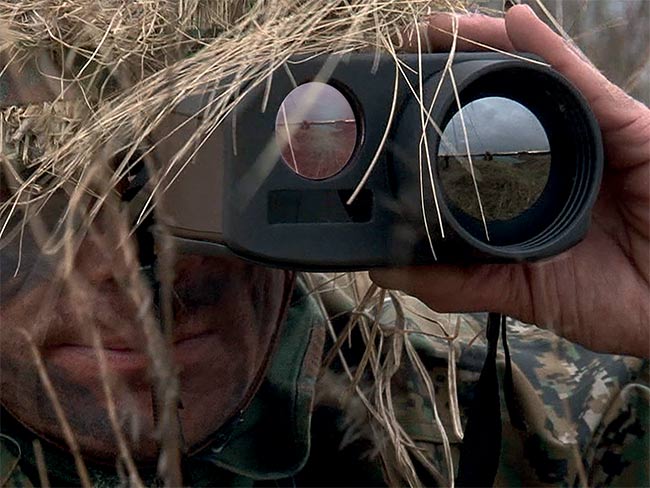
Above, Advancements in optical components, sensors, and systems make it possible to observe and locate targets under conditions
of poor visibility. Courtesy of Jenoptik.
“As the diameter of optics is defined by the necessary resolution, the weight has to be reduced in other ways,” said Ulf Krause, head of sales for safety and security at the Jenoptik Group in Jena, Germany, “for example, by using new materials that are low weight or have a high refractive index, or by new optical design and solutions that combine different optical functions in one complex but small and lightweight component.”
In the realm of photonics, Jenoptik supplies defense systems integrators and others with lens systems; optical components based on glass, IR, and polymer materials; and optical coatings for wavelength ranges from the deep UV to far-IR. It also manufactures thermal imagers, laser rangefinders, laser targeting systems, and other optical and optoelectronic components.
At times, the desire to maximize SWaP-C performance runs up against mission requirements. A major trend in defense is the use of multispectral or hyperspectral sensors, according to Krause. Such systems combine, for example, a visible capability with one in the thermal IR. These sensors enable a soldier on foot or a small drone in the sky to see an object in bright sunlight or darkest night. Because the sensors work across many spectutral bands, they can provide additional information, such as whether a vehicle’s engine has recently been running.
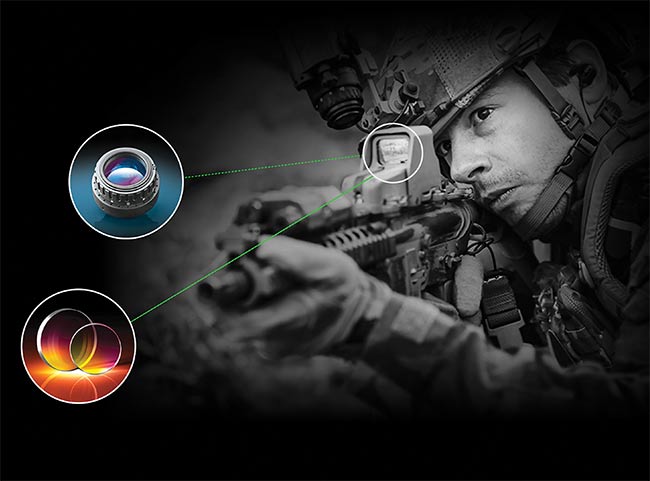
Manufactured to precise specifications and then coated, optical components offer performance and durability to dismounted war fighters.
Courtesy of Edmund Optics.
However, such sensor combinations present challenges to optical components. For one thing, IR optical materials are not the same as those in the visible. Whereas visible sensors use glass or a transparent polymer, IR systems use germanium, silicon, zinc sulfide, zinc selenide, chalcogenide glasses, sapphire, and calcium fluoride. Some of these are transparent in the visible and some are not.
From tradition to innovation
All of these materials, including those in the visible sensing part of the system, must be machined to specifications and coated. Coating may reduce reflection, thereby improving performance and diminishing the chance of detection via a telltale flash. Coatings may also be used for filtering or other performance enhancements.
Using zinc selenide, Jenoptik has developed high-performing and durable multispectral coatings and systems for the visible to the long-wave IR, according to Maxi Seifert, key account manager. She said coatings combining optical and mechanical requirements can reduce weight.
“Part of Jenoptik’s IR coatings are, for example, extremely durable diamond-like carbon [DLC] coatings and hybrid-DLC coatings that could be used for night vision or military applications,” she said.
Another issue for multi- or hyperspectral systems is that thermal IR wavelengths are about 5 µm, which is roughly 10× the 500 nm of the visible. Longer wavelengths mean the diameter of the optics would typically scale up to achieve the necessary resolution. However, if this were to happen, the size and weight of the optics would also grow — something that must be avoided if possible. This is driving vendors to innovate.
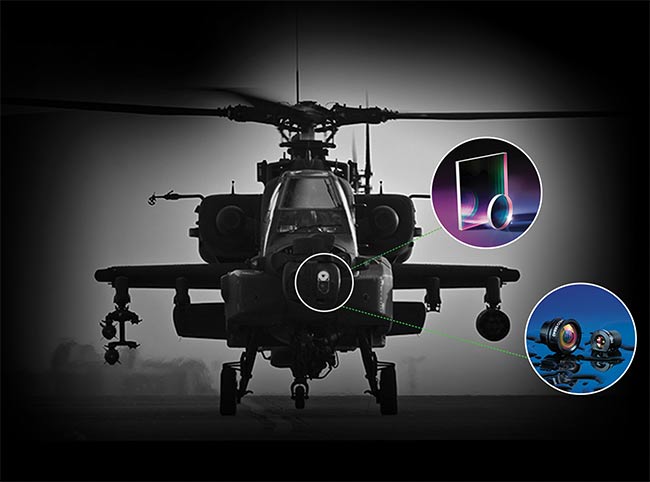
Vehicle-mounted surveillance and targeting systems depend upon the latest optical component technology. Courtesy of Edmund Optics.
Traditional optical components and manufacturing methods are increasingly challenged in other ways by SWaP-C, according to Patrick Gray, director of business development for U.S. Defense and Aerospace at Edmund Optics. For dismounted soldiers, Europe and the U.S. have similar aims in terms of SWaP-C, he said. War fighters operating on foot carry ammunition, water, and batteries along with protective gear, weapons, and targeting devices. The total weight can top 100 lbs (45 kilos).
Optics reduction
Reducing the size and weight of devices could help prevent foot, back, and shoulder problems, and allow soldiers to carry more ammunition and water. They could carry fewer batteries or go on longer missions, courtesy of reduced power consumption. To achieve lighter weight, vendors are creating sensors with smaller pixel pitches, allowing more pixels to be packed into a given area. This in turn means systems can offer the same or even better resolution in smaller packages. A smaller sensor means that the optical components can also be smaller, thus further reducing size and weight.
Achieving such a reduction in the size of optics is becoming difficult, however. “As sensors get smaller and smaller, our optics have to get smaller and smaller,” Gray said. “We’re starting to butt right up against the laws of physics, basically the diffraction limit.”
With ongoing advancements in sensors and
manufacturing, a long-term solution to reducing
SWaP-C in defense and security equipment may be
the use of freeform optical components.
Changes in materials and manufacturing offer other ways to reduce weight. In the past, the optics in a defense or security system for a soldier on foot may have consisted of seven glass lenses with spherical (concave or convex) surfaces. Some components may have had an aspherical shape that deviated to a limited degree from a spherical one. Today, constraints in size and weight along with the need to achieve even tighter tolerances mean that there may be only five or fewer components.
This is possible because two of these components may now be made of a lightweight polymer, and others may have a diffractive surface on one side and a spherical or aspherical one on the other. This approach allows the separate functions previously handled by different components to be merged into one. Other changes may involve the use of a diffraction gradient material, which has as many as 300 to 400 zones so the refractive index varies across the surface. Such materials can enable better imaging performance.
The evolution in materials and manufacturing is happening along multiple optical paths. The next generation of night vision goggles, for example, includes both thermal and night vision channels. The latter intensifies ambient light, while the former captures a heat signature — a combination that enhances the ability to spot a target and improves situational awareness.
Next-generation night vision goggles fuse these different inputs, using materials appropriate for the wavelength. The goggles provide this imaging information along with that from weapon sighting systems. These more sophisticated systems can already be found in tanks and airplanes; the advanced night vision goggles are now being issued to personnel.
Looking forward with sensors, the steady shrinking of pixel pitch will likely continue, as will the deployment of other innovations that improve size, weight, and power while challenging optical component performance.
Freeform optics
FLIR Systems, a maker of IR cameras and components based in Wilsonville, Ore., recently rolled out a new midwave-IR (3- to 5-µm wavelength) imaging technology that operates at a higher temperature, which reduces the need for cooling and therefore cuts power consumption. Some incarnations of the technology are aimed at the drone market, which also has tight SWaP-C targets. Dan Walker, vice president of product management at FLIR, said the new technology allows camera providers to increase the number of pixels while shrinking system size, reducing power, and cutting cost.
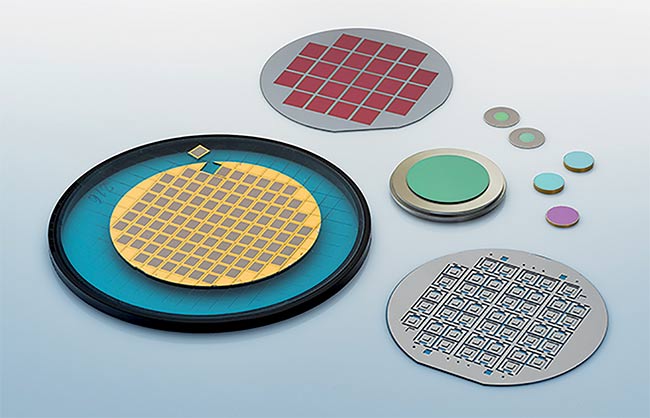
IR coatings can improve the performance and durability of optical components.
Courtesy of Jenoptik.
These improvements are possible, in part, because the new technology has smaller pixels in the camera, he said, “allowing for smaller optics for the same range and field of view as legacy systems.”
With ongoing advancements in sensors and manufacturing, a long-term solution to reducing SWaP-C in defense and security equipment may be the use of freeform optical components, said Jenoptik’s Seifert. As the name implies, the surface of a freeform optic does not follow a simple spherical shape.
Instead, a freeform optic allows a high degree of freedom in the choice of shapes because the surfaces are not constrained by rotational symmetry. Making such optics is more challenging, in part because freeform optics are harder to measure.
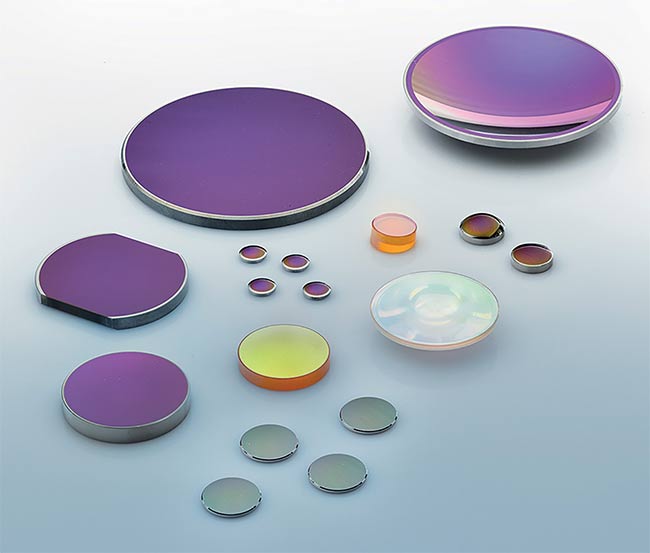
AR (antireflective) coatings improve the performance of, and reduce the chance for a telltale flash from, optical components. Courtesy of Jenoptik.
Surface tolerances may be as tight as a few nanometers. Even for IR applications, the manufacturing requirement will be, at most, to hit the target measurement for the desired shape within a few hundred nanometers. With spherical surfaces, there are well-established measurement techniques, but methods are still being developed and deployed for freeform optics.
Elaborating on how freeform optics could have an impact on reducing SWaP-C, Seifert said, “They can combine different optical functions within a single tailor-made optical component that is able to replace typical multilens assemblies, and thereby reduce the needed space in the complete system.”
[email protected]